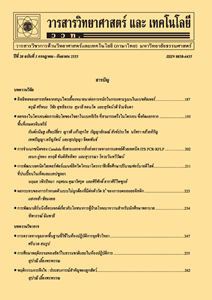การเปรียบเทียบคุณภาพข้าวขาวดอกมะลิ 105 ที่ปลูกโดยใช้ปุ๋ยเคมีและปุ๋ยอินทรีย์ในจังหวัดสุรินทร์
Main Article Content
Abstract
บทคัดย่อ
การเปรียบเทียบคุณภาพข้าวขาวดอกมะลิ 105 ที่ปลูกโดยใช้ปุ๋ยเคมีและปุ๋ยอินทรีย์ในจังหวัดสุรินทร์ โดยการสุ่มเก็บตัวอย่างข้าวเปลือกจากแปลงเกษตรกร ตำบลสังขะ อำเภอสังขะ จังหวัดสุรินทร์ ซึ่งเป็นแปลงนาที่มีการใช้ปุ๋ยเคมีภายใต้ระบบมาตรฐานสินค้าเกษตร (มกษ. 4400-2552) โดยใช้ปุ๋ยเคมีสูตร 16-16-8 อัตรา 25 กก./ไร่ และปุ๋ยเคมีสูตร 46-0-0 อัตรา 15 กก./ไร่ และแปลงนาที่มีการใช้ปุ๋ยอินทรีย์ภายใต้มาตรฐานสินค้าเกษตรอินทรีย์ (มกษ. 9000-2552) โดยใส่ปุ๋ยมูลสุกร อัตรา 50 กก./ไร่ จากผลการศึกษาพบว่าข้าวขาวดอกมะลิ 105 ที่ปลูกโดยการใช้ปุ๋ยเคมีมีคุณภาพผลผลิตด้านน้ำหนัก 100 เมล็ด ดีกว่าข้าวที่ใส่ปุ๋ยอินทรีย์และการใช้ปุ๋ยเคมีทำให้ข้าวขาวดอกมะลิ 105 มีปริมาณอะมิโลสและปริมาณโปรตีนมากกว่าการใช้ปุ๋ยอินทรีย์ จึงทำให้ข้าวมีความแข็งเพิ่มขึ้นในทางตรงกันข้าม การใช้ปุ๋ยอินทรีย์ทำให้ข้าวขาวดอกมะลิ 105 มีปริมาณอะมิโลสต่ำลงและมีปริมาณแป้งเพิ่มขึ้น จึงทำให้ข้าวมีความนุ่มเหนียว ซึ่งสอดคล้องกับการประเมินคุณภาพการยอมรับในการบริโภคทั้งจากผู้เชี่ยวชาญและผู้บริโภคทั่วไป พบว่าข้าวที่ได้รับปุ๋ยอินทรีย์มีลักษณะนุ่มเหนียวมากกว่าข้าวที่ได้รับปุ๋ยเคมี นอกจากนี้ข้าวขาวดอกมะลิ 105 ที่ปลูกโดยการใช้ปุ๋ยอินทรีย์ยังมีคุณค่าทางโภชนาการมากกว่าการใช้ปุ๋ยเคมีอีกด้วย อย่างไรก็ตาม การใช้ปุ๋ยทั้งสองประเภทนี้ไม่มีผลทำให้เกิดความแตกต่างด้านคุณภาพทางกายภาพคุณภาพการหุงต้ม ปริมาณธาตุอาหารในเมล็ด รวมทั้งคุณภาพทางเคมีบางประการ ได้แก่ ปริมาณไขมันและปริมาณสารความหอม (2-AP)
คำสำคัญ : ข้าวขาวดอกมะลิ 105; จังหวัดสุรินทร์; ปุ๋ยเคมี; ปุ๋ยอินทรีย์
Abstract
Comparing quality of Khao Dawk Mali 105 (KDML105) rice variety between chemical and organic fertilizer application was studied by randomly collect paddy sample from rice field in Sungkha subdistrict, Sungkha district, Surin province. The rice field with the application of chemical fertilizer was produced under Thai Agricultural Standard (TAS 4400-2009), which was introduced with chemical fertilizer by 16-16-8 at rate of 25 kg/rai and 46-0-0 at rate of 15 kg/rai. The rice field with the application of organic fertilizer was maintained under Organic Agricultural Standard (TAS 9000-2009), which was applied by pig manure at rate of 50 kg/rai. The results have shown that the chemical fertilizer application was increased paddy quality in term of 100-grain weight than that of organic fertilizer application. The chemical fertilizer was also affected on the higher of amylose content and protein content, which leaded to harder of cooked rice. On the other hand, organic fertilizer application was resulted in lower apparent amylose content and higher starch content which provided softer and stickier of cooked rice. Similarly with the quality of consumer acceptance by both professionals and consumers that was shown that organic rice was more tenderness than chemical rice. In addition, organic fertilizer had resulted in more nutrition of rice than chemical fertilizer. However, both type of fertilizer did not altered physical grain quality, cooking quality, nutrient content in grains and some chemical quality such as fat content and aroma (2-AP) content.
Keywords: Khao Dawk Mali 105; Surin province; chemical fertilizer; organic fertilizer


